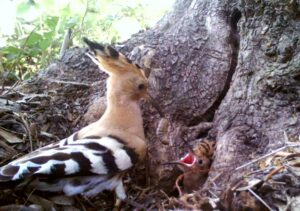Diet and foraging ecology of the Hoopoe Upupa epops in a Mediterranean area of Central Italy
Matteo Annessi, Alessio De Biase & Alessandro Montemaggiori
Abstract:
During the breeding season, the Hoopoe Upupa epops inhabits traditional and diversified rural habitats with high availability of bare ground and short grass areas where it forages. Only a few studies addressed
the breeding diet of this species. Most of them were conducted in the intensively cultivated plains of southern Switzerland, where Gryllotalpa gryllotalpa represents the most common prey. In contrast, limited information is available for Mediterranean habitats. To fill this knowledge gap, we investigated the foraging behaviour of the species in a Mediterranean heterogeneous agricultural area in Central Italy during the 2020-2021 breeding seasons. 1123 prey items brought to the nest by adults were identified using camera traps positioned near four natural nests. Insect larvae constitute 84% of the diet, of which 61% are represented by Cicada orni nymphs. The importance of cicadas in the Hoopoe diet has been never described in the literature before. C. orni seems to substitute G. gryllotalpa in the more arid and hard soil of Mediterranean areas. The observed provisioning rate to clutches showed a maximum daily mean of over 14 prey per hour. To investigate Hoopoe foraging microhabitat selection, six different microhabitat variables were measured at 64 1 m2 plots located at an equal number of foraging and random control points, by using a grid of 100 squares (10x10 cm each). Habitat selection analysis indicates that short herbaceous sward and low herbaceous cover are the fundamental factors driving foraging microhabitat selection. Our study contributed to enhancing the limited knowledge of the Hoopoe diet and foraging ecology in Mediterranean habitats and demonstrates, for the first time, the importance of Cicada orni nymphs in the diet of the species in this biogeographical region.

